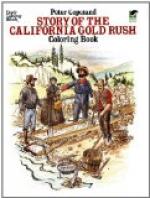In the greater part of the state the year is divided into a dry summer and a wet winter. The rains begin in October, and the first showers fall on dry, brown hills and dusty fields baked hard by steady sunshine since May. After these showers the grass springs up, and the fields are green almost as quickly as if some fairy godmother had waved her wand. An army of wild flowers, whose seeds were hidden in the brown earth, wakes when the rain-drops patter, and the plants get ready to bloom in a month or so. For this season, from November to February, with little frost and no ice nor snow, is winter in name only. Roses and violets bloom in the gardens and yellow poppies on the hills.
People expect and hope for much rain in this so-called winter, since a wet year assures good crops to the state. But the amount of rain that falls is very uncertain. It does not rain every day, nor all day, as a rule, and each storm seems different. Sometimes a “southeaster” blows up from the Japan Current, or Black Stream, as the Japanese call the warm, dark-blue waters that pour out of the China Sea. This current of the Pacific Ocean flows along our coast in a mighty river a thousand miles wide, and gives California its peculiar climate of cool summers and moist, warm winters. The southeasterly wind ruffles the bay with white-capped waves and dashes sheets of rain against window and roof. Then the wind changes, and all the clouds go flying to north or east, while from the clear blue sky brilliant sunshine pours down to make the grass and flowers grow. During the winter months the sun is strong and warm enough to make out-door life delightful.
The farmer depends greatly upon the rainfall. In a wet winter the moisture sinks far into the ground, but not so deep that the thirsty little roots cannot find it in the summer. Early rains are needed to soften the ground for November ploughing, and young grain and crops of all kinds need rain through April. In the northern part of the state the wet season begins earlier and lasts longer than in the south, while the southeastern corner is an almost rainless desert.
In San Francisco the thermometer seldom falls below 45º in the winter, the average for the season being 51º. Perhaps in January or February the sidewalks may be white with frost in the mornings, or hail may fall during some cold rain-storm. Once in five years or so, enough snow falls to make children go wild with delight over a few snowballs which are very soon melted. People can be comfortable the year round without fires, and the clear, bright winter days with soft air and warm sunshine are always pleasant enough to spend outdoors. This ocean climate, due to the warm sea air, is enjoyed by the counties facing the coast and San Francisco Bay. In the valleys of the interior white frosts are frequent, and thin ice forms on the wayside puddles. Once in a while killing frosts destroy fruit blossoms and cut down the garden flowers and vegetables, but seldom do more damage.




